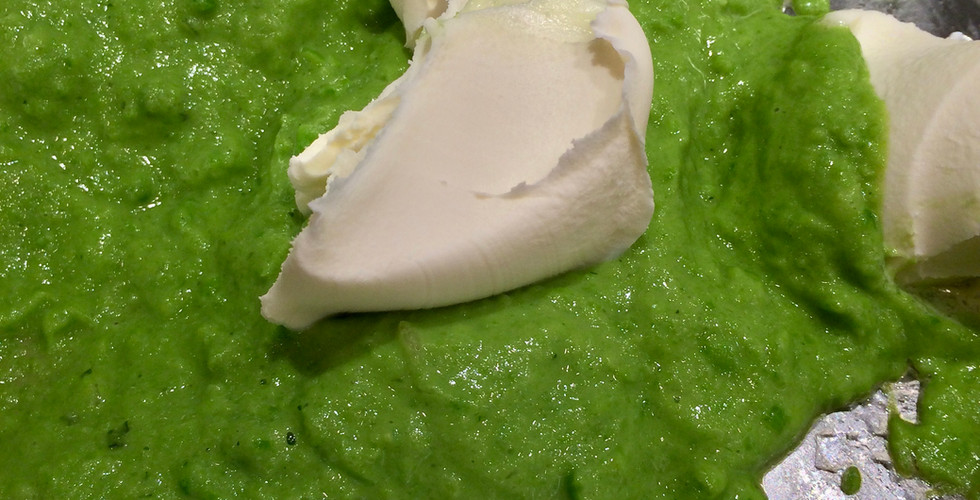Pan Seared Scallops with Pea Puree
- Tricia Cohen
- Aug 10, 2017
- 3 min read
Updated: Jan 2, 2023

My recipe for Pan Seared Scallops with Pea Puree was inspired by a recipe from the 1495 manuscript Viander de Taillevent. The recipe, le grave d'escrevisses, called for cooking shellfish (crawfish, oysters, mussels, lobster, and scallops) and serving it with a pea puree. The pea puree was thickened with ground almonds and seasoned with vinegar and spices.
In medieval times, fish was a general name used for anything that was not a land-living animal. Fish included, obviously… fish, but it also had the not-so-obvious like shellfish, whales, porpoises, seabirds, particular geese, and beavers.
Seafood was the primary diet in coastal villages, but it also was an appropriate alternative to meat on fast days throughout the land. In the areas bordering the Atlantic or the Baltic Sea, herring and cod were significant contributors to the economy. At the time, it was the most commonly traded commodity by the German Hanseatic League (confederation of merchant guilds). Kippers, made from splitting a herring that was either pickled or smoked, could be found as far away as Constantinople. The coastal villages had an abundance of shellfish, like mussels, crabs, cockles, and scallops, whereas the interior villages and towns consumed freshwater fish like trout, pike, perch, and carp. No matter where they hung their hat, the wealthy consumed fish like turbot, John-dory, skate, and sole, while the lower classes ate the lesser quality pike and perch.
I created this recipe using items that would have been available during the time (though... mascarpone is a bit of a stretch, cream-based options were available). While you are serving this simple, easy and delicious dish, you can share your knowledge of this recipe and ingredients with your guests. Won't you sound so smart? Enjoy.
Ingredients
One tablespoon of unsalted butter
One garlic clove, minced
Two fresh mint leaves, finely chopped
1 cup sweet peas
Two tablespoons of grated cheese; I used pecorino
½ cup chicken stock
Three tablespoons mascarpone
Salt and pepper, to taste
6-8 large scallops; I like U10 or any large “dry” scallops. Dry packed means that the scallops are not artificially enlarged with water (or worse… chemicals). If you are spending money on fresh seafood, spend it wisely.
Unsalted butter and olive oil for searing
Puree
In a saucepan, heat the butter on medium heat until melted.
Add the garlic and mint, and stir. This will be deliciously aromatic.
Once the garlic softens, not brown, add the peas and chicken stock.
After a few short minutes, the peas will be warm and soft; now it is time to add the cheese. Stir quickly, and remove from the heat.
Using a hand mixture or blender, mix the ingredients until smooth. Add the puree to the pan and set the heat to medium.
Stir in the mascarpone and remove from heat once it has been incorporated into the puree.
Salt and pepper to taste. Set aside
Scallops
Pat the scallops dry and remove any remaining muscles with your fingers.
Season the scallops with a sprinkling of salt and pepper.
Prepare the pan, which should be big enough to fit all your scallops comfortably.
Set the heat to medium-high, and give the pan a nice swirl of olive oil. Place the scallops on the hot pan. The secret with searing scallops is…. Leave them alone! 3-4 minutes on each side will allow for nicely browned scallops.
This is optional… but a delicious technique. Once you flip the scallops over to cook the other side, add a few pats of cold, unsalted butter. This gives the scallops a nice finish and golden color to the serving side. You can also, at the time adding butter, consider incorporating a fresh herb or spice. My favorite spice with scallops is ground coriander.
Place the scallops on a plate, buttered side up, with the pea puree. You can serve the scallops on the puree or serve them over—your preference. I placed the scallops on the puree, with a bit of mint sprinkled.

























